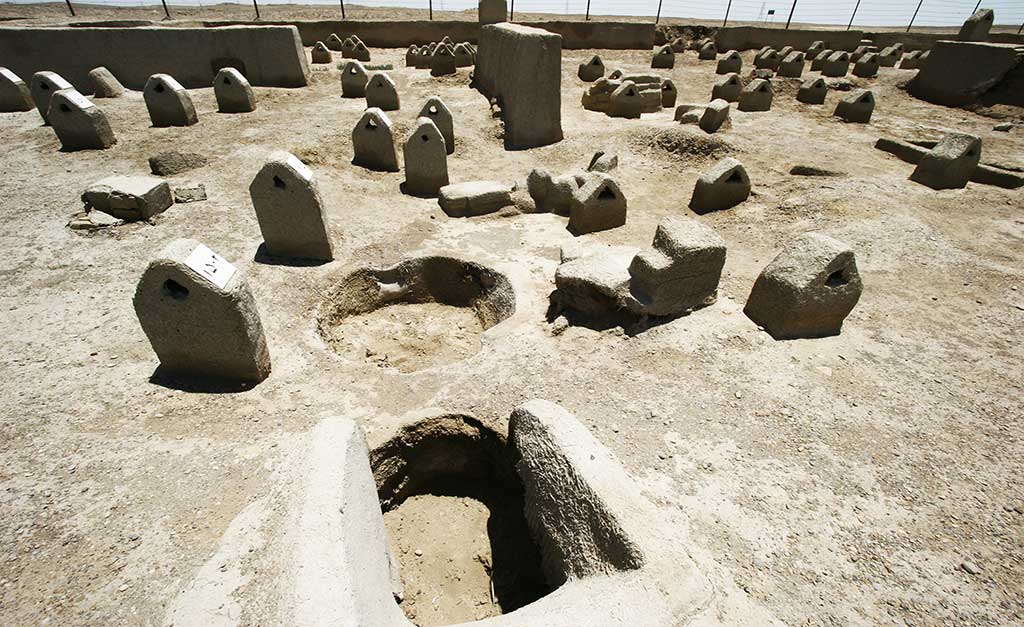Iran Travel Booking > About Iran > World Heritage Site in Iran > Shahr-i Sokhta

Shahr-i Sokhta, meaning ‘Burnt City’, is located at the junction of Bronze Age trade routes crossing the Iranian plateau. The remains of the mudbrick city represent the emergence of the first complex societies in eastern Iran. Founded around 3200 BC, it was populated during four main periods up to 1800 BC, during which time there developed several distinct areas within the city: those where monuments were built, and separate quarters for housing, burial and manufacture. Diversions in water courses and climate change led to the eventual abandonment of the city in the early second millennium. The structures, burial grounds and large number of significant artefacts unearthed there, and their well-preserved state due to the dry desert climate, make this site a rich source of information regarding the emergence of complex societies and contacts between them in the third millennium BC.
Outstanding Universal Value
Brief Synthesis
Located at the junction of Bronze Age trade routes crossing the Iranian plateau, the remains of the mud brick city of Shahr-i Sokhta bear witness to the emergence of the first complex societies in eastern Iran. Founded around 3200 BCE, the city was populated during four main periods up to 1800 BCE, during which time there developed several distinct areas within the city. These include a monumental area, residential areas, industrial zones and a graveyard.
Changes in water courses and climate change led to the eventual abandonment of the city in the early second millennium. The structures, burial grounds and large number of significant artefacts unearthed there and their well-preserved state due to the dry desert climate make this site a rich source of information regarding the emergence of complex societies and contacts between them in the third millennium BCE.
Criterion (ii): Shahr-i Sokhta exhibits a transition from village habitation to an urbanized community with significant cultural, social and economic achievements and developments from the late Calcolithic to the early Bronze Age. The site is a rich source of information regarding the emergence of complex societies and some contact between them in the third millennium BCE.
Criterion (iii): Shahr-i Sokhta bears exceptional testimony to a peculiar civilization and cultural tradition that entertained trade and cultural relations with ancient sites and cultures on the Indus Plain, southern shores of the Persian Gulf, the Oman Sea and South-west Iran, and Central Asia. Archaeological remains and finds indicate the key role of the city on a very large scale in terms of working with metals, stone vessels, gems and pottery.
Criterion (iv): The ancient site of Shahr-i Sokhta is an outstanding example of early urban planning: excavations have brought to light well-preserved evidence in the form of its mud-brick structures, burial grounds, workshops and artefacts that testify to its size, organisation, the source of its wealth and its trade and social structures. The city was separated into various parts according to different functions - residential, industrial and burial; it therefore represents an important stage in urban planning in the region.
Integrity
All elements necessary to express the property’s values are included within the property, which is of adequate size to ensure the complete representation of features and processes which convey the property’s significance. The property does not suffer from development or neglect and it is well maintained. The understanding and appreciation of its remains rely on appropriate maintenance interventions and on a coherent setting.
Authenticity
In general the surrounding desert landscape and extraordinary scatter of archaeological material present on the surface of the low hill of Shahr-i Sokhta give a strong sense of authenticity, as does the sight of the complex architecture of the various parts so far excavated. The labyrinthine succession of rooms, corridors and courtyards give a genuine impression of these ancient buildings.
Protection and management requirements
The property is in State ownership and is protected by the provisions of the Law for Protection of National Heritage (1930) and of the related bylaw (1980). Shahr-i Sokhta was registered in the list of national cultural properties of Iran as no. 542 in 1966. The property is also subject to the Regulations of Cultural and Historical Properties covering all works, research and data organisation. The property is further protected by a buffer and landscape zones where activities are regulated and subject to approval by the Iranian Cultural Heritage, Handicrafts and Tourism organisation (ICHHTO).
The archaeological excavations and finds have been documented since the 1970s and records, inventory and finds are stored and analysed at the ICHHTO multi-disciplinary Base at Shahr-i Sokhta. The excavated remains are cleaned regularly during the year and Kahgel plaster is applied to conserve exposed walls.
The property is managed by the Iranian Cultural Heritage, Handicrafts and Tourism Organisation (ICHHTO) on behalf of the government of the Islamic Republic of Iran by ICHHTO’s Base at the property, located in the buffer zone, through a management plan that includes short, medium and long term activities concerning research, conservation, visitor management and presentation. The Base is advised by a steering committee comprising regional officials and experts and a technical committee comprising regional officials and experts. The Higher Education Centre of ICHHTO and national universities provide sources of expertise and training in conservation and management. The Research Organisation of Cultural Heritage and Tourism is responsible for multi-disciplinary research and training.
Information source: http://whc.unesco.org/

















 WhatsApp us
WhatsApp us